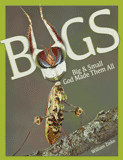Parasites—Unwelcome Guests
The last thing you’d ever invite into your home is a moocher. Yet we can’t get away from them. Parasites: our world is filled with the little monsters, and they can be pretty nasty. Where in the world did they come from?
We have all been exposed to parasites at one time or another. Perhaps your dog or cat has come home with hookworms or roundworms—or even you’ve been told you were the unwilling host of lice or fleas! They’re everywhere. In fact, far more parasites inhabit our planet than nonparasites, and three out of every five people are host to at least one. What a miserable thought!
How is this possible? Such nasty things really bother those who think God’s creation is one big “bright and beautiful” banquet of bounty. Surely the Lord didn’t include such icky things in His original creation.
And yet they seem too sophisticated to have arisen by accident. Their existence has caused stomachs to turn and hands to wring for centuries, but it doesn’t have to be so.
Before looking at the origin of parasites, it is necessary to understand precisely what a “parasite” is. The word parasite comes from the Greek word meaning “a person who eats at another’s table.” It refers to any animal (or plant) that lives together in close, non-mutual association with another, usually larger, animal (or person), called the host. How do creationists explain such unwelcome guests at our table?
Malaria — A Classic Example of a Parasite
Consider a classic example: the parasite that causes malaria. These single-celled animals take residence in a victim’s liver and red blood cells after the person is bitten by an infected mosquito. The tiny parasites eat the red pigment in blood cells and then multiply, protected by the victim’s own immune system. Well over 650 million people are currently infected, and a million people die each year.
Like most other parasites, malaria parasites move effortlessly from one environment to another. They depend on other animals or natural resources to transport them and give them a safe place to reproduce. The life cycles are incredibly complex, as the parasite moves from a human to a female mosquito and back again.
The secular community knows very little regarding parasites’ origin, their supposed evolution, or their complex biology: “Complex life cycles remain one of the most baffling features of parasites, and there is still much to be learned about their evolution.”1
For centuries people thought malaria was acquired by breathing “bad air” or mal aria, such as what is found around swamps. But after decades of painstaking research and intense rivalry among scientists, the final piece of the malaria puzzle was at last put into place in 1898. Indeed, the history of understanding malaria reads like an exciting detective novel.2 But understanding “what is”—already a difficult goal—doesn’t tell us “how it came to be.”
Clues from God’s Word about Parasites
Creationists maintain that evolutionists will never truly understand parasites because they begin with a faulty premise: supposed evolution. Evolutionists ignore Genesis 1, where God announced at the end of the six-day Creation Week that everything He made was “very good” (verse 31). According to Genesis 1:29–30, the first humans and all animals were vegetarian, and the original world was truly perfect. But in Genesis 3 we read how Adam’s rebellion brought corruption and a curse upon this idyllic creation. As a result, we now have all these evil things—parasites that feed at the table of others, fierce animals that kill, and genetic mutations that disfigure and destroy.
The Bible gives creation scientists some intriguing ideas regarding the origin of parasites.
The Apostle Paul explains that “the whole creation groans and labors” because of sin’s entry into the world (Romans 8:22). In this groaning world, parasites are ugly reminders of “the law of sin and death” that now rules the world (Romans 8:2). Death is God’s enemy, and it started with Adam. But we don’t have to be discouraged. Christ’s saving work on the Cross doomed death, and some day “there shall be no more curse” (Revelation 22:3).
The Bible gives creation scientists some intriguing ideas regarding the origin of parasites. As a result of the Curse described in Genesis 3, God may have allowed some beneficial structures in creatures to deteriorate into the devastating effects we have today, including weeds and poisons. Or current-day creatures, such as the malaria organism, could be slight genetic variations of their non-parasite ancestors that lived before the Fall.
The Bible does not tell us exactly what God changed when He cursed the earth after Adam’s sin, but it could include modifying animal designs. Genesis 3:14 says that God told the serpent he was cursed above all cattle and above every beast of the field, showing that these animals were cursed as well. God also did this with plants, which now grow thorns and thistles to cause pain.
So how might this help us understand the origin of parasites and their complex life cycles today?
Consider one example, the creature that transports the malaria parasite—the mosquito. Females have specially designed needle-like structures (stylets) that allow them to pierce flesh and obtain a meal of blood. God may have adjusted the original design of these creatures at the time of the Curse, allowing them to feed off other creatures. Or perhaps female mosquitoes lived off high-protein plant extracts before the Fall, using their mouthparts to penetrate into the plant tissues.
Interestingly, the single-celled malaria parasite has an unusual part (called an apicoplast) that is very similar to the photosynthetic parts in plants and algae (called plastids) that produce food out of sunlight.3 Conceivably at the time of the Fall or later, this complex ability to produce their own food was lost, and these creatures then became parasitic.
This type of thinking, based on a biblical perspective, will help us solve the origin of parasites. It appears that the Curse included an easing of God’s original biological controls that kept creatures from causing harm or death. Genetic mistakes (mutations) might have contributed to these changes. Creation zoologists do not yet have all the answers, but we must start with the historical facts God reveals in Scripture. Based on these facts, we can then hypothesize and test theories about the origin of parasite life cycles.
Some creation zoologists suggest that free-living creatures (in other words, non-parasites) became parasitic after the Fall. This is hardly far-fetched. As some evolutionists recently stated, “Free-living species could become parasitic without substantial anatomical or physiological changes.”4 So the step from a beautiful role to a parasitic one after the Fall could have been a small one.
Answers Magazine
January – March 2013
Learn about our culture's newest tactics in the battle for kids' souls, and discover what you can do in your home and church to reclaim our youth for Jesus, the Creator. In addition to this special section of three articles, you'll find all the creation content you expect from Answers magazine, including a look at Lucy, the famous ape; animals with "sixth senses"; ancient and modern reefs; and intriguing findings about the animal kinds on Noah's Ark.
Browse IssueFootnotes
- Robert Poulin, Evolutionary Ecology of Parasites, 2nd ed. (Princeton, New Jersey: Princeton University Press, 2006), p. 40.
- Gordon Harrison, Mosquitoes, Malaria, and Man (New York: E. P. Dutton, 1978).
- Laura V. Parada, “The Apicoplast: An Organelle with a Green Past,” Nature Education 3 (9): 10.
- Stephen Miller and John Harley, Zoology, 8th ed. (New York: McGraw Hill Co., 2009), p. 226.
Recommended Resources

Answers in Genesis is an apologetics ministry, dedicated to helping Christians defend their faith and proclaim the good news of Jesus Christ.
- Customer Service 800.778.3390
- Available Monday–Friday | 9 AM–5 PM ET
- © 2025 Answers in Genesis





